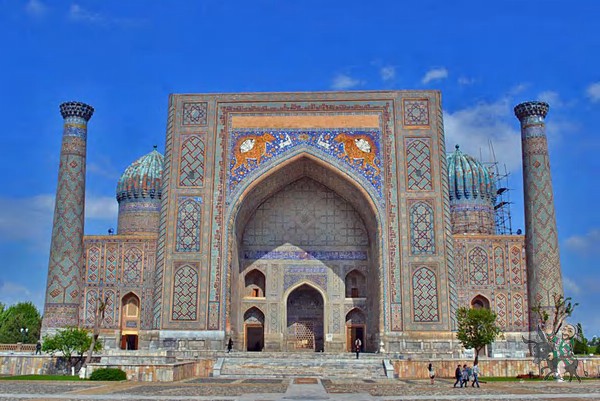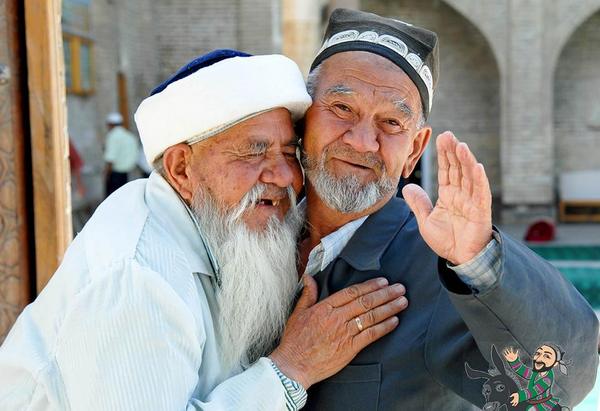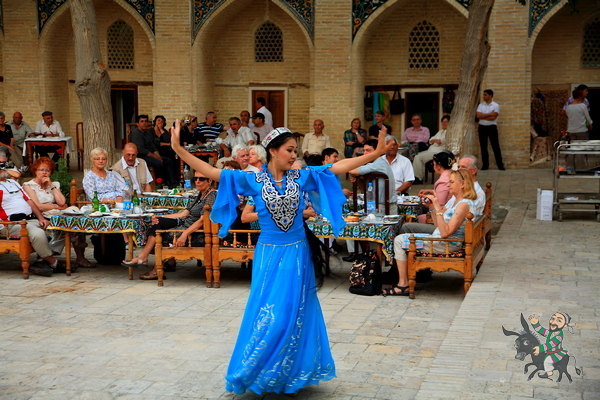After breakfast at the hotel the guide will invite you to continue the tour. If the previous objects of the show are as if embedded in the modern Bukhara building, the central part of the “old” city is an integral architectural ensemble of XVI-XVII centuries.
You will begin your tour with the complex of constructions Poi – Kalyan (“the foot of the Great”), grouped around the highest minaret of Bukhara – Kalyan (tower for calling to prayer). It was built in 1127. Its height is 47 meters, inside there are 105 steps leading to the top.
Building masonry and facings are made of burnt brick. The minaret stands on a monolithic foundation, sunk deep into the ground, which provides it with great strength. On the right side of the minaret rises the majestic building of the cathedral mosque Masjidi – Kalyan, erected in the first half of the XV century. over the remains of the medieval mosque XI-XII centuries.
It was rebuilt and renovated in 1514. Its high – raised dome, lined with bricks painted in blue color, argues with the bright blue sky. The inner courtyard of the mosque is framed by covered galleries, which support 288 domes with their powerful pillars.
Coolness and dusk reign here even on hot days. Opposite the mosque is the building of the Miri Arab Madrasa, erected by the influential sheikh (head of the religious order) Miri Arab of Yemen in 1535-36. Both externally and internally the building is decorated with colored mosaics.
This is a functioning madrasa where young men are trained to serve in mosques. In addition to the Koran, they also study natural sciences. Near the religious center of Bukhara there were shops of traders and workshops of craftsmen selling their goods. Old bazaars
The old bazaars of Central Asia were usually always covered. Galleries and domes protected from scorching sun rays in summer and from rain and snow in winter. A number of closed trade passages – tims – have been well preserved.
Very peculiar are domed market buildings – taki. To the XV century. refers to the dome of jewelers – Taki – Zargaron, to the XVI century – the dome of sellers of hats – Tilpak – Furushon, the dome of changers – Taki – Sarafon and Tim Abdullahan, designed for the sale of silk.
In the covered passages of the city, which are still in operation today, you can buy wonderful products of applied art, for which Bukhara has been famous since ancient times. One of the most ancient mosques – Magokki-Attari – is located near the trading rows.
According to written sources, it appeared on the place of a pagan temple, but later it was substantially rebuilt in the XII century, and then in the XVI century. The main facade with an asymmetrically located portal, striking with the variety of figurative brickwork and ornamentation of terracotta tiles (made of burnt clay), forming a real stone lace, has been preserved from the original building.
Walking a little along the narrow streets of medieval Bukhara, you will come to one of the largest sources of water supply in the city – Lyabi – Hauz. Water from the Shakhrukh canal, which flows through the city, was not always enough for the inhabitants, especially in summer.
Therefore, water was stored in primitive small reservoirs (khauz) or ponds. The almost square Lyabi-Hauza reservoir was built in 1620. It is framed by three monumental buildings: Khanaka Nadir – Divan – Begi (a strange house for dervishes and pilgrims) – the 20-ies of the XVI century; the second building – Madrasah Kukeltash (1568-69) – it was one of the largest madrasahs of its time (160 hujras – cells); Madrasah Nadir-Divan-Begi (1622).
Its facing is dominated by stylized vegetation motifs, among which the images of flying phoenixes stand out. For centuries, the territory where the Hauz is located, with the adjacent buildings, served as a place of rest and walks of Bukhara residents.
This tradition has been preserved even nowadays. Then you will go (by motor transport) to the north of Bukhara to the country residence of the last emirs of Bukhara – Sitora-i-Mahi-Khasa (late XIX c. – 1918). The old palace, built by Bukhara masters who studied Russian architecture in St. Petersburg and Yalta, is a mixture of European and Bukhara styles.
The new palace is a complex of buildings (also of mixed Oriental and European styles): a gate arch, a harem, a greenhouse, a covered gallery and the main building. The most interesting in this palace are the interiors of the White Hall and the reception hall. The walls and ceilings are decorated with the richest carving and painting on ganch (gypsum) in the traditions of Bukhara architectural and decorative school.
Carved gates with forged copper nails and handles decorated with fine chasing should be attributed to the undoubted attraction of Makhasa (as Bukharians lovingly call it). The palaces are located in a beautiful park with a variety of ornamental and fruit trees, lawns, a huge pond.
Once a part of the territory was occupied by a zoological garden, where gazelles, pheasants and peacocks walked on the grass, the latter walk freely and nowadays. The rich excursion program can be interrupted (at your request at any time) for lunch and dinner in the restaurants of the city.














